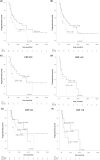The prognostic and predictive roles of plasma C-reactive protein and PD-L1 in non-small cell lung cancer
- PMID: 37329173
- PMCID: PMC10469721
- DOI: 10.1002/cam4.6262
The prognostic and predictive roles of plasma C-reactive protein and PD-L1 in non-small cell lung cancer
Abstract
Background: Anti-PD-(L)1 agents have revolutionized the treatment paradigms of non-small cell lung cancer (NSCLC), while predictive biomarkers are limited. It has been previously shown that systemic inflammation, indicated by elevated C-reactive protein (CRP) level, is associated with a poor prognosis in anti-PD-(L)1 treated. The aim of the study was to analyze the prognostic and predictive value of CRP in addition to traditional prognostic and predictive markers and tumor PD-L1 score.
Methods: We identified all NSCLC patients (n = 329) who had undergone PD-L1 tumor proportion score (TPS) analysis at Oulu University Hospital 2015-22. CRP levels, treatment history, immune checkpoint inhibitor (ICI) therapy details, and survival were collected. The patients were categorized based on CRP levels (≤10 vs. >10) and PD-L1 TPS scores (<50 vs. ≥50).
Results: In the whole cohort (n = 329), CRP level of ≤10 mg/L was associated with improved survival in univariate (HR 0.30, Cl 95% 0.22-0.41) and multivariate analyzes (HR 0.44, CI 95% 0.28-0.68). With ICI treated (n = 70), both CRP of ≤10 and PD-L1 TPS of ≥50 were associated with improved progression-free survival (PFS) in univariate (HR 0.51, CI 95% 0.27-0.96; HR 0.54, CI 95% 0.28-1.02) and multivariate (HR 0.48, CI 95% 0.26-0.90; HR 0.50, CI 95% 0.26-0.95) analyzes. The combination (PD-L1 TPS ≥50 and CRP >10) carried a high negative predictive value with a median PFS of 4.11 months (CI 95% 0.00-9.63), which was similar to patients with low PD-L1 (4.11 months, CI 95% 2.61-5.60).
Conclusions: Adding plasma CRP levels to PD-L1 TPS significantly increased the predictive value of sole PD-L1. Furthermore, patients with high CRP beard little benefit from anti-PD-(L)1 therapies independent of PD-L1 score. The study highlights the combined evaluation of plasma CRP and PD-L1 TPS as a negative predictive marker for ICI therapies.
Keywords: CRP; ICI; NSCLC; PD-L1; predictive; prognostic.
© 2023 The Authors. Cancer Medicine published by John Wiley & Sons Ltd.
Figures


References
-
- Schachter J, Ribas A, Long GV, et al. Pembrolizumab versus ipilimumab for advanced melanoma: final overall survival results of a multicentre, randomised, open‐label phase 3 study (KEYNOTE‐006). Lancet. 2017;390:1853‐1862. - PubMed
-
- Robert C, Schachter J, Long GV, et al. Pembrolizumab versus Ipilimumab in Advanced Melanoma. N Engl J Med. 2015;372:2521‐2532. - PubMed
Publication types
MeSH terms
Substances
LinkOut - more resources
Full Text Sources
Medical
Research Materials
Miscellaneous

